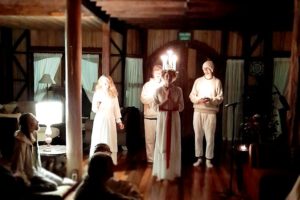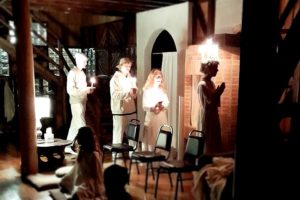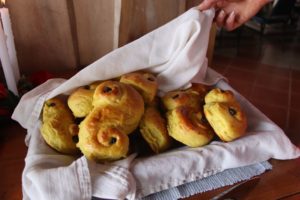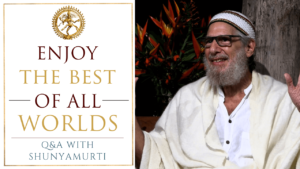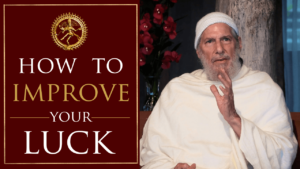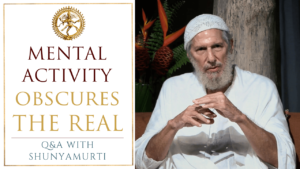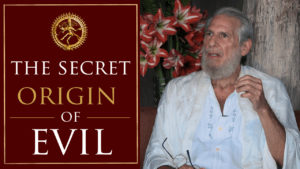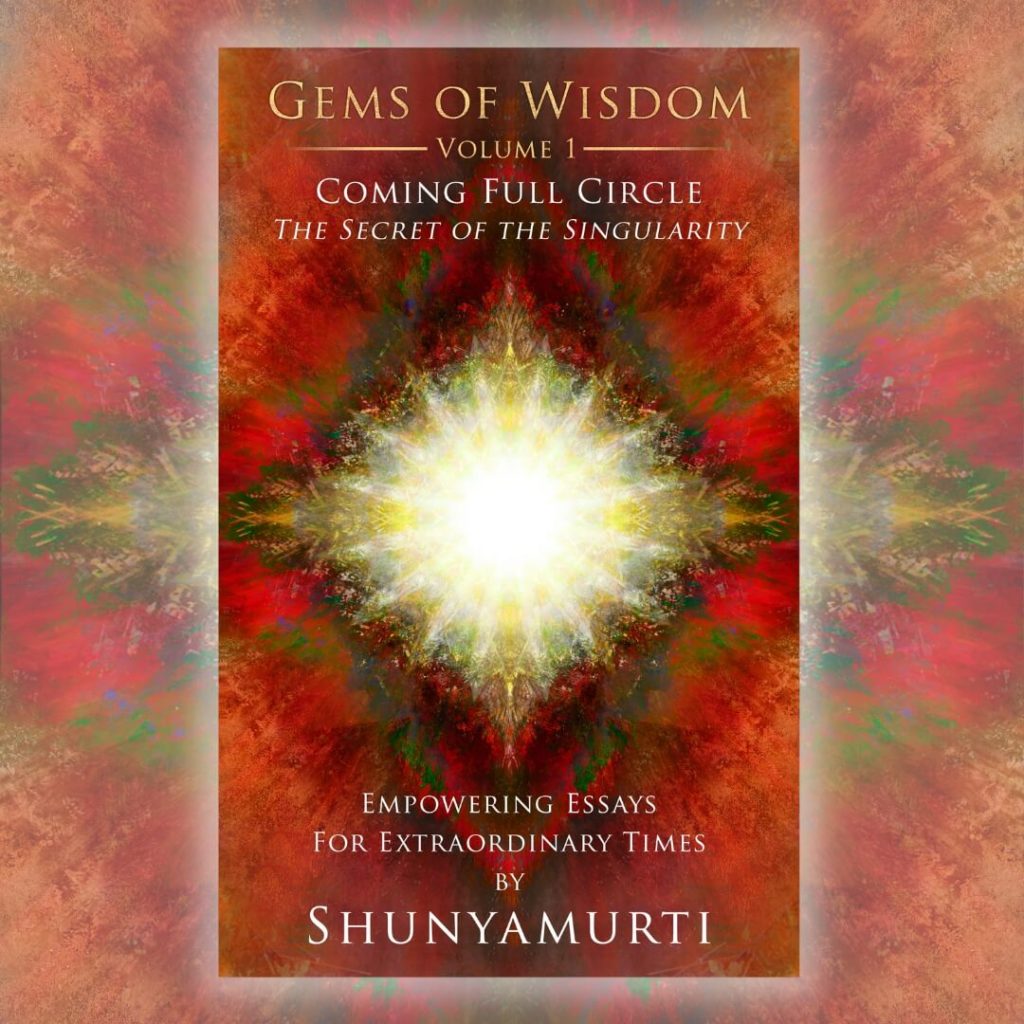Blog by Nirgun

On December 13, at the end of the sangha’s 4am meditation sitting, the melodious sounds of a Swedish tradition entered into the silence as the gentle candlelight that celebrates the day of Sankta Lucia brought light into the darkness of the early morning hours.
This year, our Scandinavian sangha members blessed us with a traditional Sankta Lucia procession and song. This tradition happens all over Sweden in every school, hospital and workplace, as well as online, and now, at our ashram!
People gather together on this day to balance in the still point between darkness and light and to align themselves with the Supreme Light, both as individuals and as a collective.
Celebrate the Light
By Nirmala
Sankta Lucia arrives in her white robe which represents purity and a red sash for martyrdom. She wears a wreath with lit candles on her head and leads a procession of singers sweetly serenading the morning with Sankta Lucia’s Song.
She brings with her freshly baked sweet buns flavored with saffron, which makes them yellow, to symbolize the light, called lussekatter (literally translated as Lucy’s cats due to the shape which looks like the curled up tail of a cat). (See recipe below).
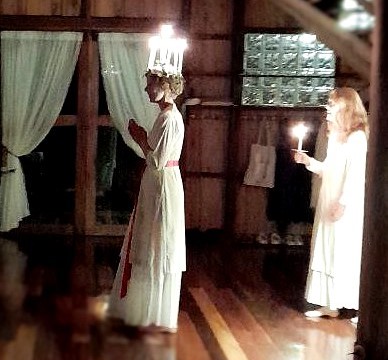
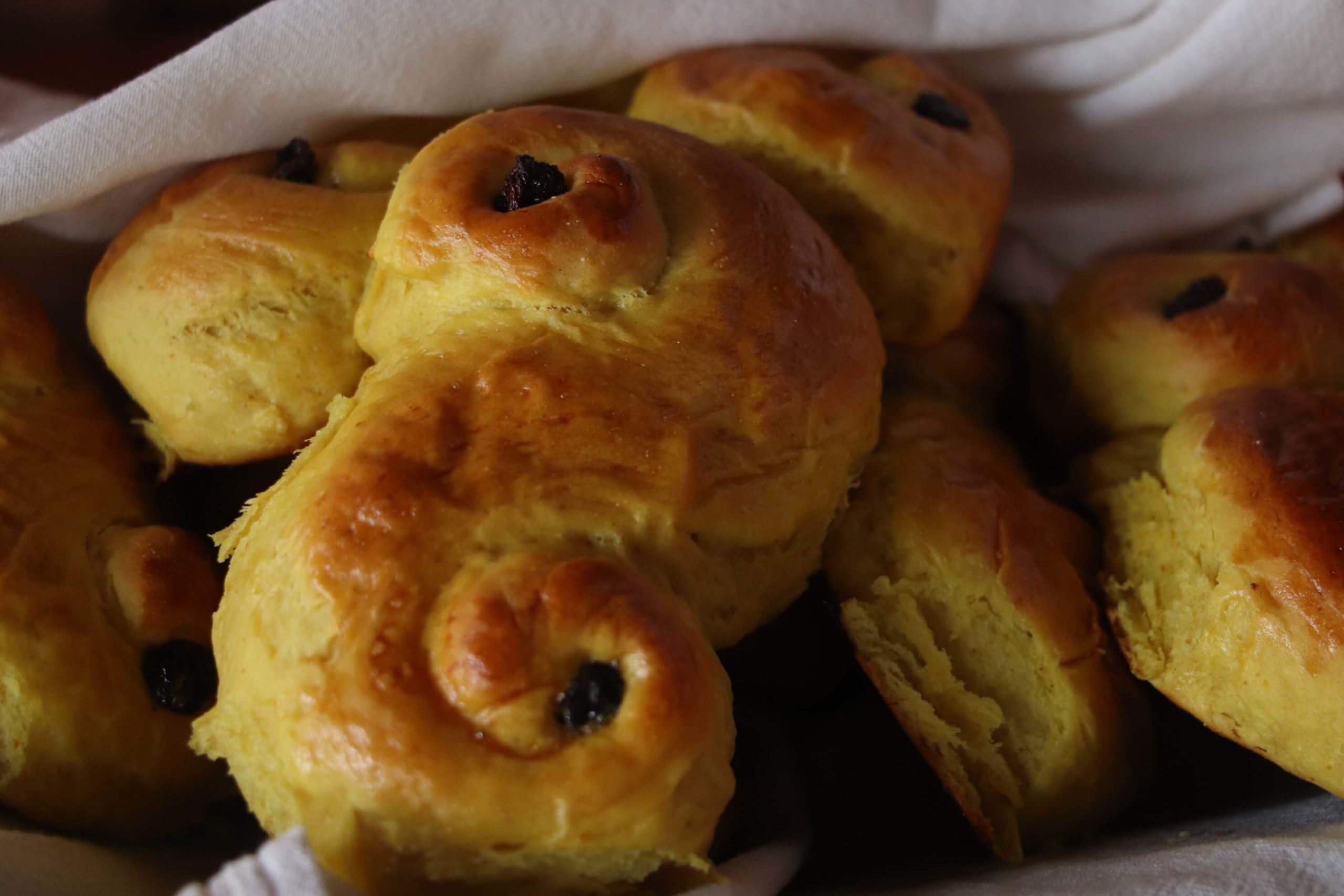
Sankta Lucia’s name is a reference to light, both in the literal and figurative senses. The light of faith is invoked for protection on the darkest day of the year, the winter solstice.* The word solstice means “the day the sun stands still,” and derives from the two Latin words sol (sun) and sistere (to stand still). The winter solstice has been, since pagan times, the main celebration during the dark winter days in Scandinavia and is hailed as a time of rebirth–since out of the darkness, the light is reborn–and for taking new steps forward, as the days get longer and longer.
Up until the 21st of June, of course, the brightest day of the year, when the balance flips, and the darker days begin approaching once again, as the play of light and dark continues on its cyclical journey. This day is also one of our grandest holy days, called midsummer. In Sweden, we love to celebrate the light!
*According to the Julian calendar, the solstice was celebrated on the 13th of December, but this was changed to the 21st of December in 1920, when the Gregorian calendar was introduced. In Sweden, Sankta Lucia is still celebrated on December 13.
Sankta Lucia’s Song
Inspired Translation by Ashoka
The darkness slouches
Around our homestead
In a land forgotten by the sun
Here only shadows brood
Then in our darkest hour
She rises with the flame,
Our Saint Lucia.
The night, a muted vastness
But… Listen! As it flutters
In all our empty rooms
The sounds of angel wings
Look! There on our threshold stands
All in white, with light streaming from her hair, Our Saint Lucia
The darkness shall soon be vanquished
From the valley of the earth
These words – her gift
From embers, the day will be reborn
Rising in her awakened majesty
Our Saint Lucia.
Natten går tunga fjät
Natten går tunga fjät,
runt gård och stuva.
Kring jord som sol’n förlät,
skuggorna ruva.
Då i vårt mörka hus,
stiger med tända ljus,
Sankta Lucia, Sankta Lucia.
Natten var stor och stum.
Nu, hör, det svingar
i alla tysta rum,
sus som av vingar.
Se, på vår tröskel står,
vitklädd med ljus i hår,
Sankta Lucia, Sankta Lucia.
Mörkret skall flykta snart,
ur jordens dalar.
Så hon ett underbart
ord till oss talar.
Dagen skall åter gry,
stiga ur rosig sky,
Sankta Lucia, Sankta Lucia.
Saint Lucy, the Martyr and the Legend
As the story goes, Lucy was born in 280 AD, the daughter of a noble Sicilian family. Lucy developed a deep and profound calling to serve God as a young girl, leading her to choose a Christian path of renunciation and selfless service, rather than marrying the Roman nobleman to whom she was betrothed. He resents her choice, and he betrays her, which leads to her arrest, and like so many others who have been prosecuted for their faith, Lucy was tortured and martyred.
Legend has it that she had her eyes gouged out, which is depicted in some paintings and myths. It is believed that this is how she became the patron saint of the blind.
During the torture, she declared that she couldn’t be hurt or defiled without her consent. It is said that she even prolonged the torture to show Christians not to fear death and martyrdom. She is a testament to the fact that we are not our bodies.
Over the centuries, the legend of Saint Lucy traveled throughout Europe and all the way to the northern kingdom of Sweden in the 1800’s. As Pagan and Christian roots became intertwined, the story of Saint Lucy joined together with the myth of the Pagan goddess Freja, who was known for her chariot pulled by felines (hence the name lussekatter for the sweet buns!), and whose youngest son Baldur was born on the winter solstice, akin to the traditional Christmas celebration of Jesus’s birth, both sons symbolizing the light overcoming the darkness. And thus, the Nordic equivalent of Sankta Lucia was born–and this beautiful celebration of the return of the light has arrived!
Shining with Spiritual Light
My first memories of Lucia are from when I was a young girl growing up in Sweden. Going to school in the early morning on every thirteenth of December was exciting, as I knew this would be a special day of celebration. The morning was quiet, except for the muffled sound of my boots as I walked through deep snow, the stars glittering above in the dark blue sky, the landscape covered with virgin snow, and the mist coming off my breath into the cold air. As I hurried to get to school, there was the wonderment of who would be chosen to be Lucia and wear the crown of light? And of course, I was also looking forward to tasting some of those delicious lussekatter!
Today, many years later, after living for over a year at the Sat Yoga Ashram in Costa Rica, where the climate is different but the Sankta Lucia celebration here remains the same, it is a joy to be able to share this sacred annual tradition with our community—and now with our whole global sangha. The spiritual light from the great martyred soul Lucia continues to shine through the centuries and throughout the world, offering yet another sign from God to have faith in the ultimate victory of light over darkness.
Namaste,
Nirmala
Lussecats or St. Lucia Saffron Buns
Makes 12 buns
You will need:
- 50 g fresh yeast
- 175 g butter
- 2 cups milk
- 1 g saffron
- 2 dl white sugar
- 900 g all purpose flour
- 1 egg
- Raisins
Directions:
Preheat the oven to 400 °F .
- Crumble the yeast into a bowl. Melt the butter on low heat and add the milk. Heat until 115° Fahrenheit or warm enough to touch with your knuckle, but not hot. Add the saffron and sugar and stir. Let it rest for 5-10 minutes in a warm place until it starts to foam. Now start to add some of the flour while whisking, and then slowly add the rest while kneading the dough until all the flour is assimilated. It should be a little sticky to the touch but not so much you can’t handle it. If it is too sticky, add some more flour.
- Cover with a baking towel and let it rise in a warm place for 60 minutes until it has doubled in size.
- Scoop out onto a lightly floured baking table and divide into twelve pieces ( 70 g each). Roll each ball into a long “cats tail” about 12- 14 inches. Curl the ends in opposite directions forming an “S”. Stick a raisin in each of the centers of the “S” spiral. Place the bun on a lined baking sheet. Let it rise for another 30-45 minutes.
- Whisk the egg with a fork and brush the buns. Bake for 10 to 12 minutes until golden brown.
- Remove and let cool for 15 minutes before serving. These buns are best eaten fresh.

